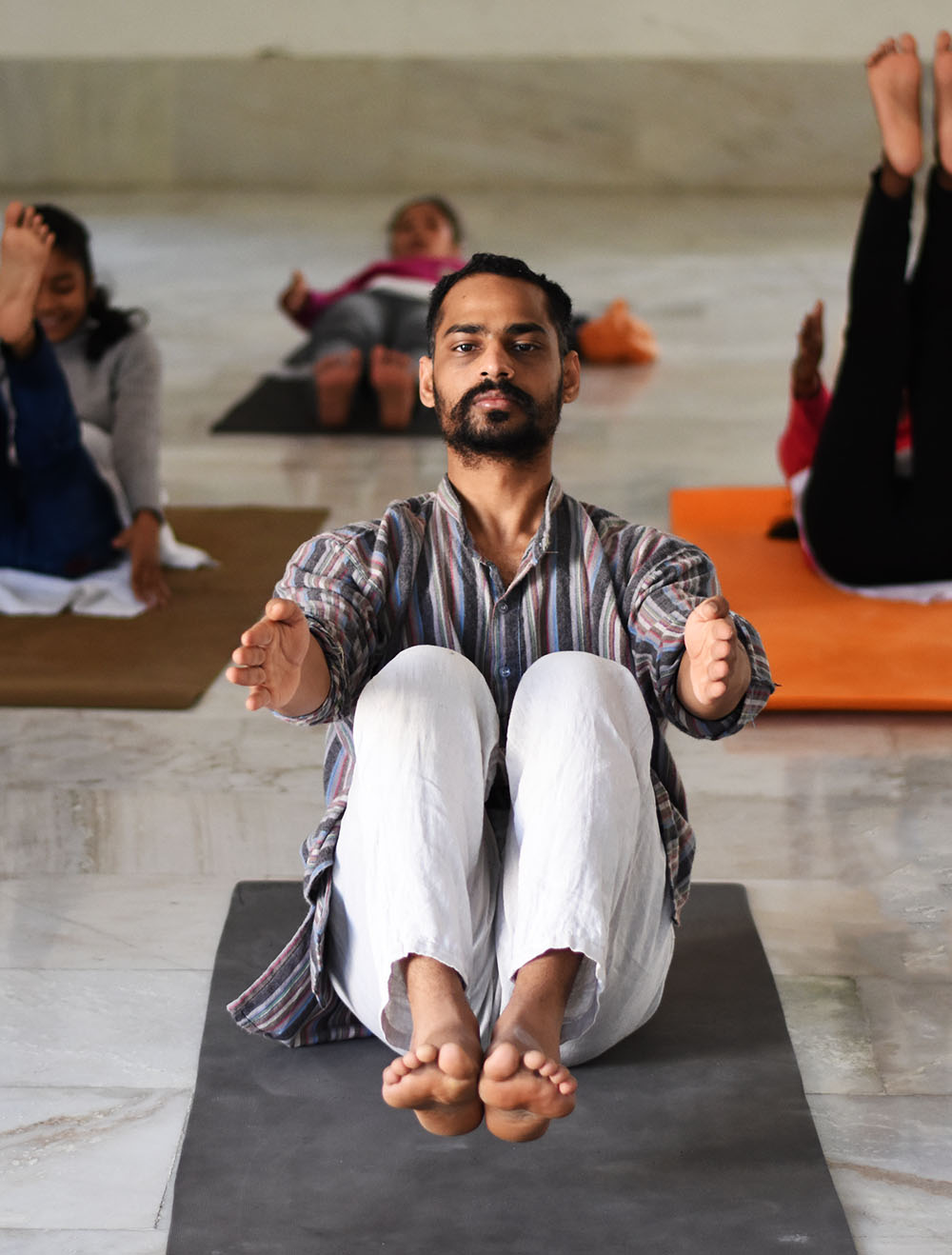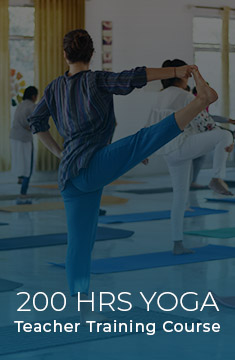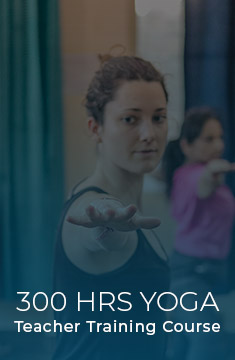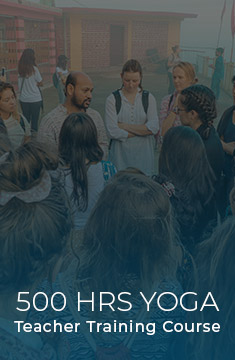Posture
“The method for purifying and strengthening the body is called asana” (Jois 2002 22). In Ashtanga yoga India , asana is grouped into six series. “The Primary Series [Yoga Chikitsa] detoxifies and aligns the body. The Intermediate Series [Nadi Shodhana] purifies the nervous system by opening and clearing the energy channels.
The Advanced Series A, B, C, and D [Sthira Bhaga] integrate the strength and grace of the practice, requiring higher levels of flexibility and humility. Each level is to be fully developed before proceeding to the next, and the sequential order of asanas is to be meticulously followed. Each posture is a preparation for the next, developing the strength and balance required to move further” (Pace). Without an earnest effort and reverence towards the practice of yama and niyama, however, the practice of asana is of little benefit (Flynn).
Breathing
The breathing technique performed with vinyasa is called ujjayi [victorious breath] (Scott 20), which consists of puraka [inhalation] and rechaka [exhalation] (“Ashtanga Yoga”). “Both the inhale and exhale should be steady and even, the length of the inhale should be the same length as the exhale” (“Ashtanga Yoga”).
Over time, the length and intensity of the inhalation and exhalation should increase, such that the increased stretching of the breath initiates the increased stretching of the body (Scott 21). Long, even breathing also increases the internal fire and strengthens and purifies the nervous system (“Ashtanga Yoga”).
In Ashtanga Yoga India teaching -Bandhas are essential components of the ujjayi breathing technique. Bandha means “lock” or “seal” (Scott 21). The purpose of bandha is to unlock pranic energy and direct it into the 72,000 Nadi [energy channels] of the subtle body (Scott 21). Mula Bandha is the anal lock, and uddiyana bandha is the lower abdominal lock (“Ashtanga Yoga”). Both bandhas “seal in energy, give lightness, strength and health to the body, and help to build a strong internal fire” (“Ashtanga Yoga”).
Mula bandha operates at the root of the body to seal in prana internally for uddiyana bandha to direct the prana upwards through the nadis (Scott 21). Jalandhara bandha is the “throat lock” (Jois 2002 23, n.27), which “occurs spontaneously in a subtle form in many asanas due to the dristi (“gaze point”), or head position” (Scott 23). “This lock prevents pranic energy [from] escaping and stops any build-up of pressure in the head when holding the breath” (Scott 23). Without bandha control, “breathing will not be correct, and theasanas will give no benefit” (“Ashtanga Yoga”).
Looking Place: Dristhi is the gazing point on which one focuses while performing the asana (“Ashtanga Yoga”). “There are nine dristhis: the nose, between the eyebrows, navel, thumb, hands, feet, up, right side and left side.Dristhi purifies and stabilizes the functioning of the mind” (“Ashtanga Yoga”).
In the practice of asana, when the mind focuses purely on inhalation, exhalation, and the drishti, the resulting deep state of concentration paves the way for the practices of dharana and dhyana, the six and seventh limbs of Ashtanga yoga (Scott 23).
Instruction in pranayama can begin after one has learned the asanas well and can practice them with ease (Jois 2002 23). “Pranayama means taking in the subtle power of the vital wind through rechaka [exhalation], puraka[inhalation], and kumbhaka [breath retention]. Only these kriyas, practiced in conjunction with the three bandhas[muscle contractions, or locks] and in accordance with the rules, can be called pranayama” (Jois 2002 23). The three bandhas are “mula bandha, uddiyana bandha, and jalandhara bandha, and they should be performed while practicing asana and the like” (Jois 2002 23). “When mula bandha is perfect, mind control is automatic” (“Ashtanga Yoga”). “In this way did Patanjali start Yoga. By using mulabandha and by controlling the mind, he gradually gained knowledge of Yoga” (Jois 2003 11).
Practicing asana for many years with correct vinyasa and tristhana gives the student the clarity of mind, steadiness of body, and purification of the nervous system to begin the prescribed pranayama practice (Flynn). “Through the practice of pranayama, the mind becomes arrested in a single direction and follows the movement of the breath” (Jois 2002 23). Pranayama forms the foundation for the internal cleansing practices of Ashtanga yoga(Flynn).
The four internal cleansing practices—pratyahara, dharana, dhyana, and samadhi—bring the mind under control (Stern and Summerbell 35). When purification is complete and mind control occurs, the Six Poisons surrounding the spiritual heart [kama (desire), krodha (anger), moha (delusion), lobha (greed), matsarya (sloth), and mada(envy)]—”will, one by one, go completely” (Stern and Summerbell 35), revealing the Universal Self. In this way, the correct, diligent practice of Ashtanga Yoga under the direction of a Guru “with a subdued mind unshackled from the external and internal sense organs” (Jois 2002 22) eventually leads one to the full realization of Patanjali’s eight-limbed yoga.
Our Ashtanga Yoga India – 200 Hour yoga teacher training,we cover up mysore led style practice of Primary series.and course covers the flow sequence of Vinyasa yoga flow aligning to Astanga yoga practices.
Ashtanga Yoga Primary Series

Ashtanga Yoga Primary Series

Yog Rishi Patanjali Says:-
This is an art and science of traditional yoga for self-realization. Yoga means “union” of parts of our selves. It is similar our absorption in Samadhi. Sutra means “thread” or “multiple threads” weaved in the tapestry of insight in its plural form.
When Patanjali compiled the yoga sutra, no new systems were created but existing systems were rewritten. These Sutras are thought to be 400 BC, as various evidence suggest. Oral traditions indicate the periods may even longer.
The above practice was done to make “yoga sutra” more understandable, to focus on the practical suggestions on what to do regulate “human mind” so that it can allow a practitioner to attain experience beyond its mind.
OVERVIEW OF YOGA SUTRA:
Yoga has been mentioned in Vedas, Upnishads and Bhagwat Gita etc. Patanjali has provided the very essence of the philosophy and teaching of yoga in a scientific and systematic manner. They are divided into four parts:
- Samadhi Pada
The first chapter provides the purpose and definitions. Various approaches can be used to achieve the objectives.
- Sadhana Pada
The second chapter contains a practical approach to achieving goals of yoga. It provides “eight” limbs of yoga called Ashtanga Yoga (covered below).
- Vibhuti Pada
The third chapter talks about some of the aspects of the super-natural-power, a yogi may be able to adapt.
- Kaivalya Pada
The forth chapter is about the nature of the human mind, mental perception, desires, knowledge, and liberation that may follow is discussed.
ASHTANGA YOGA (8 LIMBS)
- Yamas (self-restraints): These are the guidelines for how to interact with the outside world. There are five Yamas:
- Ahimsa: Non-violence.
- Satya: Truthfulness
- Asteya: Non-stealing
- Brahmacharya: Abstinence
- Aparigraha: Non Coveting
- Niyamas (observance): These are guidelines for self discipline. There are five Niyamas:
- Shocha: Cleanliness
- Santosha: Contentment
- Tapas: Austerity
- Swadhyaya: Study of scriptures and self-study.
- Ishwar Pranidhana: Surrender to God.
- Asanas (posture): These should be comfortable, steady so that a yogi and sit and meditate.
- Pranayama (breath control): It means stretching or expansion of prana (breath control).
- Prathayahara (senses control)
- Dharana (concentration and / or focus): single point object.
- Dhyana (meditation): Uninterrupted floe of mind to the object (divine).
- Samadhi (total absorption): Even self-awareness or mind disappears and only object shines.








